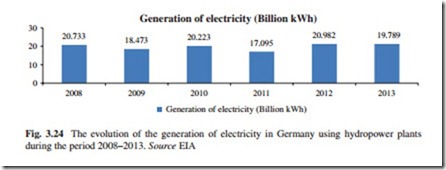Germany
In 2010, the revised water law entered into force. The extension of provisions on the management of surface water bodies is particularly relevant for the use of hydropower for electricity generation. Pursuant to Article 33 of the Federal Water Act (Wasserhaushaltsgesetz), damming, abstracting, or diverting water is only admissible if a sufficient minimum water flow is guaranteed. Article 34 of the same act stipulates that the construction, substantial modification, or operation of a dam is only admissible if the continuity of the water body is maintained or restored where this is necessary to achieve the management goals. Article 35 specifies the ecological requirements for hydroelectric power plants. They may only be operated if adequate measures for the protection of the fish population are taken. This was done to ensure that fish may pass hydropower plants unharmed during migration.
According to the Federal Ministry for Environment, Nature Conservation, Building and Nuclear Safety, at the end of 2006, about 7,300 small hydroelectric plants (<1 MW) were in operation in Germany, generating around 11 % of all hydroelectricity produced. The remaining share comes from 354 medium-sized or large hydropower plants. Only 12 % of the hydropower plants are owned by energy utilities, but these generate more than 90 % of all hydroelectricity. The overall installed capacity in 2012 was 4,264 MW, of which around 700 MW must be considered non-domestic since they come from hydropower plants located on the border with other countries.
Germany’s Southern Länder have the largest hydropower potential as the Alpine foothills provide a favorable slope of terrain. Replacement, modernization, and reactivation of existing plants and new construction in existing transverse structures constitute a major potential for hydropower.
In all cases, balanced consideration of environmental impacts must be taken into account. The German government’s goal is to increase the output while improving ecological water parameters at the same time. Due to the incentives for investment approved by the government, a modernization of larger hydropower plants can be expected in the years to come.
The potential for building new dams, however, appears quite limited given the geography of the country on the one hand and environmental concerns on
the other. Thus, hydroelectricity is not the first choice when it comes to searching for new production capacities. According to the Bundesverband Erneuerbare Energien, however, there seems to be some potential to extend the use of hydro- electricity in the country during the coming years. Their projections aim at a more than 50 % increase in hydroelectricity production by 2020, which then would amount to 32 TWh.
Hydropower Electricity Generation
In Germany in 2012, around 21.225 billion kWh of hydroelectricity were generated. This represents around 3 % of the total electricity generated in the country using all available energy sources.
The evolution of the generation of electricity in Germany using hydropower plants during the period 2008–2012 is shown in Fig. 3.24.
According to Fig. 3.24, the generation of electricity in Germany using hydro- power plants during the period 2008–2013 increased 2.3 %. It is expected that this general trend will continue during the coming years, particularly after 2022 when all nuclear power reactors will be shut down by the government and nuclear energy will be excluded from the country energy mix.
